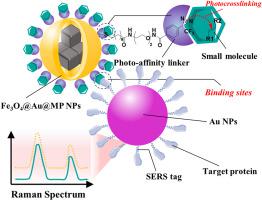当前位置:
X-MOL 学术
›
Anal. Chim. Acta
›
论文详情
Our official English website, www.x-mol.net, welcomes your feedback! (Note: you will need to create a separate account there.)
Quantification of binding capacity of natural products to target proteins by sensors integrating SERS labeling and photocrosslinked molecular probes
Analytica Chimica Acta ( IF 5.7 ) Pub Date : 2024-06-25 , DOI: 10.1016/j.aca.2024.342911 Jianhui Xie , Shuying Mao , Yanglan Zhao , Guimin Zhang , Jingchun Yao , Yongxia Guan , Jizhong Yan , Hui Zhang
Analytica Chimica Acta ( IF 5.7 ) Pub Date : 2024-06-25 , DOI: 10.1016/j.aca.2024.342911 Jianhui Xie , Shuying Mao , Yanglan Zhao , Guimin Zhang , Jingchun Yao , Yongxia Guan , Jizhong Yan , Hui Zhang

|
Natural products-based screening of active ingredients and their interactions with target proteins is an important ways to discover new drugs. Assessing the binding capacity of target proteins, particularly when multiple components are involved, presents a significant challenge for sensors. As far as we know, there is currently no sensor that can accomplish high-throughput quantitative analysis of natural product-target protein binding capacity based on Raman spectroscopy. In this study, a novel sensor model has been developed for the quantitative analysis of binding capacity based on Surface-Enhanced Raman Spectroscopy (SERS) and Photocrosslinked Molecular Probe (PCMP) technology. This sensor, named SERS-PCMP, leverages the high throughput of molecular probe technology to investigate the active ingredients in natural products, along with the application of SERS labelling technology for target proteins. Thus it significantly improves the efficiency and accuracy of target protein identification. Based on the novel strategy, quantitative analysis of the binding capacity of 20 components from Shenqi Jiangtang Granules (SJG) to α-Glucosidase were completed. Ultimately, the binding capacity of these active ingredients was ranked based on the detected Raman Intensity. The compounds with higher binding capacity were Astragaloside IV (Intensity, 138.17), Ginsenoside Rh2 (Intensity, 87.46), Ginsenoside Rg3 (Intensity, 73.92) and Ginsenoside Rh1 (Intensity, 64.37), which all exceeded the binding capacity of the positive drug Acarbose (Intensity, 28.75). Furthermore, this strategy also performed a high detection sensitivity. The limit of detection for the enzyme using 0.1 mg of molecular probe magnetic nanoparticles (MP MNPs) was determined to be no less than 0.375 μg/mL. SERS-PCMP sensor integrating SERS labeling and photocrosslinked molecular probes which offers a fresh perspective for future drug discovery studies. Such as high-throughput drug screening and the exploration of small molecule-target protein interactions in vitro.
中文翻译:

通过集成 SERS 标记和光交联分子探针的传感器定量天然产物与靶蛋白的结合能力
基于天然产物的活性成分及其与靶蛋白相互作用的筛选是发现新药的重要途径。评估目标蛋白的结合能力,特别是当涉及多种成分时,对传感器提出了重大挑战。据我们所知,目前还没有传感器能够完成基于拉曼光谱的天然产物-目标蛋白结合能力的高通量定量分析。在这项研究中,基于表面增强拉曼光谱(SERS)和光交联分子探针(PCMP)技术,开发了一种新型传感器模型,用于定量分析结合能力。该传感器名为SERS-PCMP,利用分子探针技术的高通量来研究天然产物中的活性成分,以及对目标蛋白质的SERS标记技术的应用。从而显着提高了目标蛋白鉴定的效率和准确性。基于该策略,完成了参芪降糖颗粒(SJG)中20种成分与α-葡萄糖苷酶结合能力的定量分析。最终,根据检测到的拉曼强度对这些活性成分的结合能力进行排名。结合能力较高的化合物为黄芪甲苷IV(强度,138.17)、人参皂苷Rh2(强度,87.46)、人参皂苷Rg3(强度,73.92)和人参皂苷Rh1(强度,64.37),均超过阳性药物阿卡波糖的结合能力(强度,28.75)。此外,该策略还具有较高的检测灵敏度。使用 0.1 mg 分子探针磁性纳米颗粒 (MP MNP) 测定该酶的检测限不低于 0.375 μg/mL。 SERS-PCMP 传感器集成了 SERS 标记和光交联分子探针,为未来的药物发现研究提供了全新的视角。例如高通量药物筛选以及体外小分子-靶蛋白相互作用的探索。
更新日期:2024-06-25
中文翻译:

通过集成 SERS 标记和光交联分子探针的传感器定量天然产物与靶蛋白的结合能力
基于天然产物的活性成分及其与靶蛋白相互作用的筛选是发现新药的重要途径。评估目标蛋白的结合能力,特别是当涉及多种成分时,对传感器提出了重大挑战。据我们所知,目前还没有传感器能够完成基于拉曼光谱的天然产物-目标蛋白结合能力的高通量定量分析。在这项研究中,基于表面增强拉曼光谱(SERS)和光交联分子探针(PCMP)技术,开发了一种新型传感器模型,用于定量分析结合能力。该传感器名为SERS-PCMP,利用分子探针技术的高通量来研究天然产物中的活性成分,以及对目标蛋白质的SERS标记技术的应用。从而显着提高了目标蛋白鉴定的效率和准确性。基于该策略,完成了参芪降糖颗粒(SJG)中20种成分与α-葡萄糖苷酶结合能力的定量分析。最终,根据检测到的拉曼强度对这些活性成分的结合能力进行排名。结合能力较高的化合物为黄芪甲苷IV(强度,138.17)、人参皂苷Rh2(强度,87.46)、人参皂苷Rg3(强度,73.92)和人参皂苷Rh1(强度,64.37),均超过阳性药物阿卡波糖的结合能力(强度,28.75)。此外,该策略还具有较高的检测灵敏度。使用 0.1 mg 分子探针磁性纳米颗粒 (MP MNP) 测定该酶的检测限不低于 0.375 μg/mL。 SERS-PCMP 传感器集成了 SERS 标记和光交联分子探针,为未来的药物发现研究提供了全新的视角。例如高通量药物筛选以及体外小分子-靶蛋白相互作用的探索。






































 京公网安备 11010802027423号
京公网安备 11010802027423号